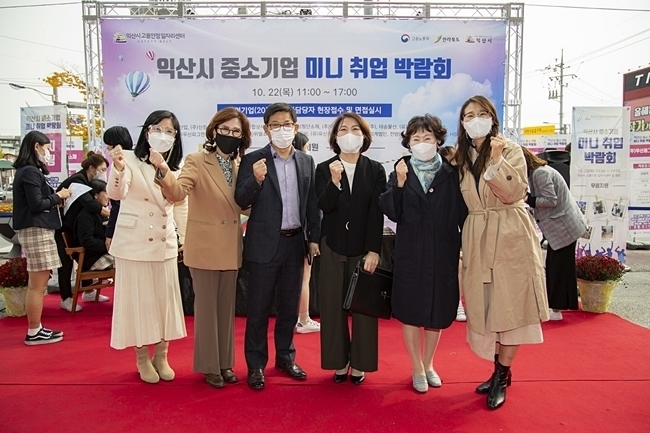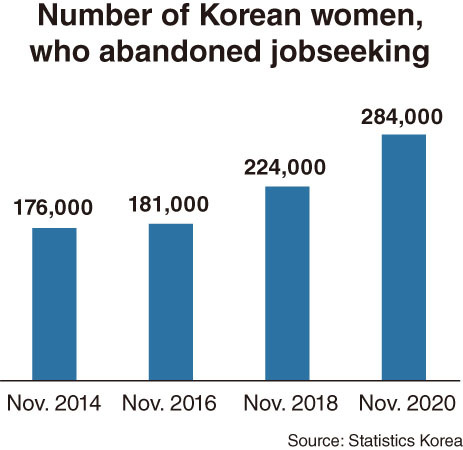[News Focus] More Koreans giving up looking for jobs
Tally for female discouraged workers hits record-high
By Kim Yon-sePublished : Dec. 24, 2020 - 17:09

SEJONG -- A growing number of South Koreans have abandoned looking for jobs as the pandemic worsens a hiring market that was already tightening for several years.
According to a survey on the working age population -- those aged 15 or over -- by Statistics Korea, the number of discouraged workers stood at 534,000 in December 2019, the month before the novel coronavirus first arrived in Korea.
The tally counts people who had looked unsuccessfully for a job in the previous year but not in the month immediately preceding the survey.
Since the first case was reported here on Jan. 20, the tally of discouraged workers has showed a general increase, though there were some ups and downs from month to month.
Compared to December 2019, the tally for November 2020 grew 97,000 to reach 631,000.

Further, the number of women who gave up looking for jobs hit an all-time high of 284,000 (tied with the figure for September 2020) last month, up 54,000 compared to December 2019.
Male discouraged workers increased by 43,000 (14.1 percent) to 347,000 over the same period.
Some research analysts say that the climbing number of discouraged workers cannot wholly be attributed to the COVID-19 pandemic. An analyst compared the latest data with the figure for April 2017, a month before the Moon Jae-in administration took office.
Compared to April 2017, the tally of people giving up job-seeking activities surged 51.4 percent (214,000) -- 47.6 percent for men and 56 percent for women.
According the Supplementary Index III for Employment, held by Statistics Korea, the tally for de facto unemployed reached 3.9 million as of November 2020. This indicates that 13 percent of the economically active population, 30 million, were unemployed or underemployed.
Index III counts underemployed people among the de facto unemployed. This category includes those who work fewer than 36 hours a week and want to work more, as well as seasonal workers who are out of work for part of the year.
Given 3.29 million for the category in April 2017, the number of de facto unemployment has increased by 610,000 during President Moon’s term.
The government is still promoting and publicizing jobless figures - but uses a more conservative method to calculate them.
Under this approach, the nation’s “official” unemployment was 3.4 percent in November, with only 967,000 unemployed.
For those aged between 15-29, the jobless rate stood at 8.1 percent last month when calculated by the government’s preferred method, with the number of unemployed at 331,000.
In contrast, the Index III figure came to 1.16 million for that age group, with a de facto jobless rate of 24.4 percent.
In April 2017 unemployment benefit payments totaled 444.9 billion won ($401.7 million), according to the Korea Employment Information Service. But the figure had shot up to 1.01 trillion won by October 2020.
By Kim Yon-se (kys@heraldcorp.com)





![[From the Scene] Monks, Buddhists hail return of remains of Buddhas](http://res.heraldm.com/phpwas/restmb_idxmake.php?idx=644&simg=/content/image/2024/04/19/20240419050617_0.jpg&u=20240419175937)





![[Graphic News] French bulldog most popular breed in US, Maltese most popular in Korea](http://res.heraldm.com/phpwas/restmb_idxmake.php?idx=644&simg=/content/image/2024/04/18/20240418050864_0.gif&u=)


![[From the Scene] Monks, Buddhists hail return of remains of Buddhas](http://res.heraldm.com/phpwas/restmb_idxmake.php?idx=652&simg=/content/image/2024/04/19/20240419050617_0.jpg&u=20240419175937)

![[KH Explains] Hyundai's full hybrid edge to pay off amid slow transition to pure EVs](http://res.heraldm.com/phpwas/restmb_idxmake.php?idx=652&simg=/content/image/2024/04/18/20240418050645_0.jpg&u=20240419100350)

![[Today’s K-pop] Illit drops debut single remix](http://res.heraldm.com/phpwas/restmb_idxmake.php?idx=642&simg=/content/image/2024/04/19/20240419050612_0.jpg&u=)